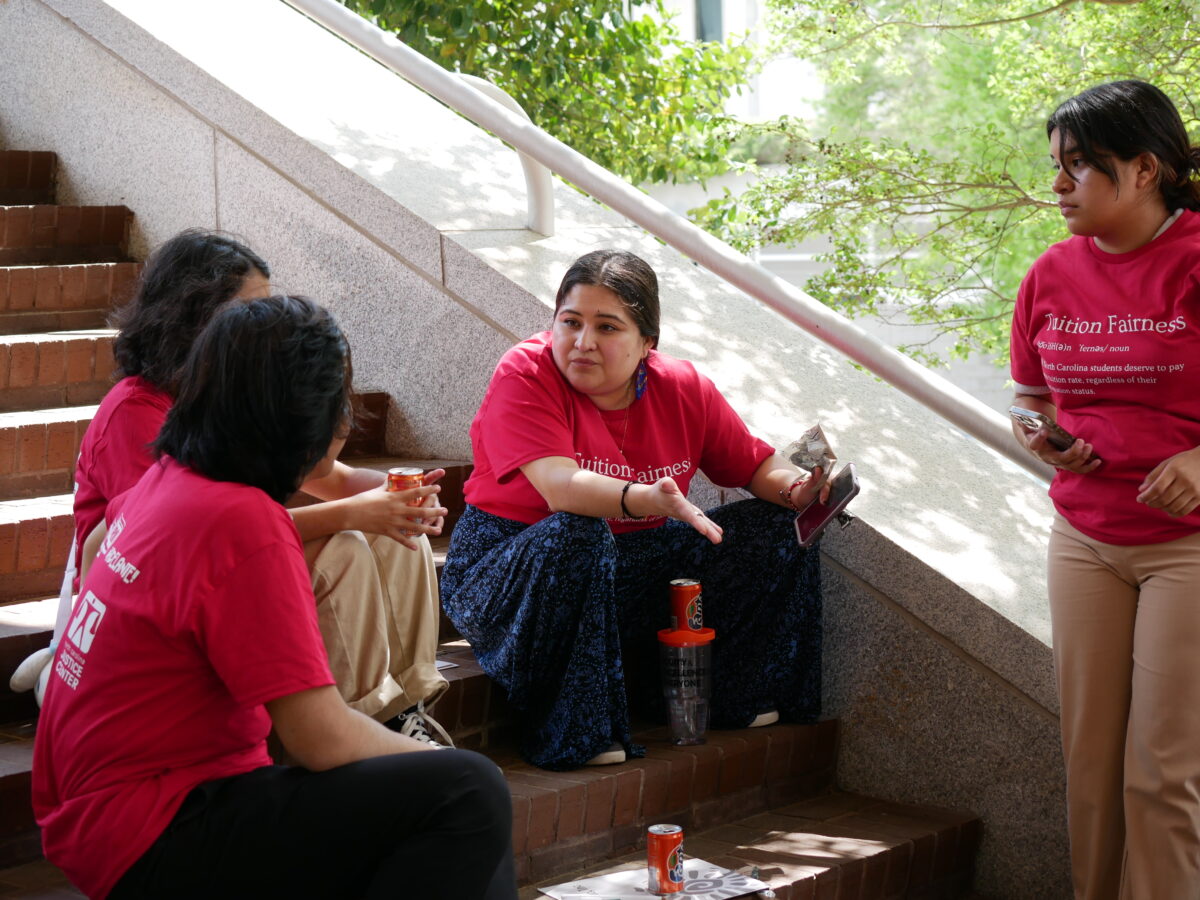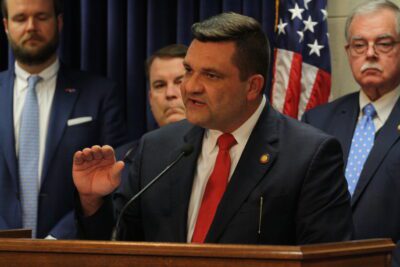
|
|
Part II
Better public policies are crafted when there is balance in political power.
Echo chambers are just that.
A cohort of provisions in different bills that have already been filed in this long session pose a threat to overall funding for public schools, but even more importantly to enrollment.
As a state, if we care about public education, collectively it’s on us to provide that balance. Now.
Students were at the legislature Wednesday advocating for fair tuition for all students regardless of immigration status. It can’t be just up to them.



In Part I, we explore the impact of the Republican’s newly-acquired supermajority, the details of the bills, and the questions raised.
A refresher on marketing
In North Carolina and in other states, policymakers note this will increase competition, and it will.
The competition should be to deliver the best education to our students, whatever the setting.
As enrollment looms for 2023-24, district leaders need to make sure parents in their counties understand the choice and quality provided by our public schools. That’s also a now.
Katie Test Davis is the founder of Forthright Advising. She started out working with public information officers and now finds herself among the Forbes Next 1000. Forthright Advising works with public school districts to get “one step ahead” of enrollment trends.
From researching local audiences of parents making the school choice decision, to thinking about how values help parents overcome pain points, to making sure parents are getting information about public school choice where they find information online, it’s an offensive strategy worth considering.
Here you can get their free guide to boosting public school enrollment.
Here are helpful suggestions on how to think about values and pain points of parents and how to distribute information to them, meeting them where they are.
A provision of Senate Bill 420 would provide funding allow the N.C. State Education Assistance Authority to contract for up to $500,000 “with a nonprofit corporation representing parents and families for outreach and scholarship education and application assistance for parents and students.”
At least a similar amount of money should be provided to a nonprofit corporation that represents students and families served by our public schools for similar outreach and enrollment assistance.
Advocacy 101
Rep. Zack Hawkins, D-Durham, and then-Sen. Bob Steinburg, R-Chowan, issued an important reminder together back in November 2021, speaking to the NC10 but about education advocacy.
“Advocacy is job number 1,” said Steinburg. “Having relationships is paramount.”
“When it comes down to advocacy and how that can happen, you are failing if you don’t have your legislator on your campus at least twice an academic year,” said Hawkins. “And you need to be here (at the legislature). Where are you? I haven’t seen you in awhile. When I don’t see you in awhile, that’s a problem.”

To our superintendents
Superintendents, many of you are the CEO of the largest employer in your county. Not that you needed one more thing to do.
Imagine the influence and power of those we think of as our largest employers county by county.
Why don’t we think of our districts in the same way?
In these counties, the district is the largest employer, which should be considered by parents as they consider the array of choices that may be presented to them:
Alamance-Burlington School System, Alexander County Schools, Alleghany County Board of Education, Anson County Board of Education, Ashe County Board of Education, Avery County Schools, Beaufort County Schools, Brunswick County Board of Education, Cabarrus County Schools, Camden County Board of Education, Carteret County Board of Education, Caswell County Schools, Catawba County Schools, Chatham County Schools, Cherokee County Board of Education, Clay County Board of Education, Cleveland County Schools, Currituck County Board of Education, Dare County Schools, Davidson County Schools, Franklin County Schools, Gates County Board of Education, Graham County Schools, Guilford County Board of Education, Harnett County Schools, Henderson County Board of Public Education, Hoke County Board of Education, Johnston County Public Schools, Jones County Board of Education, Lincoln County Schools, Macon County Public Schools, Madison County Schools, Martin County Board of Education, Mitchell County Board of Education, Montgomery County Board of Education, Pender County Schools, Perquimans County Schools, Person County Schools, Polk County Public Schools, Randolph County Board of Education, Public Schools of Robeson County, Rockingham County Consolidated Schools, Rutherford County Board of Education, Stanly County Schools, Stokes County Schools, Transylvania County Schools, Tyrrell County Board of Education, Union County Public Schools, Wake County Public Schools, Warren County Schools, and Wayne County Public Schools.
That’s 51 of our districts. In another 43, our districts are the second or third largest employer. In just six, they are the fourth or fifth largest employer. All of our districts are in the top five employers in their county.
These policy changes will impact your workforce and local economies, especially in small, rural counties.
Please help your school boards and county commissions understand the impact so that town and county, school and community college leadership can join together to advocate for our public schools.
The power of the “go and see”
It is time for legislators to get on a school bus at o-dark-thirty in the morning and meet the students, bus drivers, teachers, principals, and superintendents they serve. It is time for them to spend a whole day in class observing instruction — instead of the all too brief dog-and-pony show they sometimes get. It is time for them to sit down for coffee with our superintendents and hear the challenges districts are facing with too many pressures to name on their budgets.
Not just once, but over and over again.
The power of the “go and see” is not new.
Ken Royall served in both houses of the legislature from 1967-1992. He was respected for his command of the state budget, earning him the nickname, “The Bear.”
Journalist Ruth Sheehan once wrote an article about a conversation she had with Royall’s son. The Bear, so the story goes, took legislators on the appropriations committee to visit places across the North Carolina that would be impacted by decisions about the state budget.
“Before we allocate any money for the state, all of us are going to go take a look at the people who can’t care for themselves,” Royall said to his son.
As the story was handed down to me, The Bear encouraged us to think about the impact as if it were on our own family and to treat and serve others as if they were family.
To educators and everyone else
Much of my career has been spent trying to make sure people across the state are comfortable and confident participating in state government, from walking into the legislature to interacting with policymakers.
Here is what I think you need to know to be an effective advocate.
What else can you do?
Vote. Encourage others to vote. Work in precincts and support the democratic process.
Run for office. When educators run for office, they keep public school issues at the forefront. In 2024, we need an educator running for office in every single county.
Learn more about education policy. I recommend the Public School Forum of NC’s Education Policy Fellowship Program.
In states where “leaps and bounds” are being made, leaders have found ways to work across difference. Build relationships locally and statewide. As the midterms approach and these issues become more polarized, more politicized, and more divisive, it means we need to be talking more not less. I recommend Duke’s North Carolina Leadership Forum.
The governor in Idaho, Brad Little, a Republican, said, “If you’re running a business, you know you can only attract and retain dedicated, quality workers by paying them competitively, offering good benefits, and making them feel valued. Our educator workforce is no different.”
It is beyond hard to be an educator right now.
Thank our teachers, principals, and superintendents in all the ways.
A refresher on market share
According to Fiscal Research, ADM has increased on average 0.37% over the last 10 years for traditional public schools and charter schools.
These bills would impact the ADM of both.
Traditional public schools
There are 2,484 schools in our 115 school districts serving 1,397,273 students.
Public schools offer an abundance of fit for students and choice for parents: year round, charter, language immersion, single sex, early college, career academies, virtual academies, alternative schools, lab schools, many magnet options, and more.
You can find ADM by school districts for 2022-23 here on page seven.
Charter schools
Charter schools are celebrating their 25th anniversary in North Carolina. By law, they are public schools.
After House Bill 955 passed in 1996, 34 charter schools opened in North Carolina for the 1997-98 school year. A cap of 100 charter schools remained in place until legislation was passed in 2011.
Currently there are 206 charter schools serving 151,485 students in North Carolina.
Private schools
There are 828 private schools — including 297 independent schools and 531 religious schools — in North Carolina serving 115,311 students in 2021-22.
You can see the distribution by county in this report.
Homeschools
There are 100,905 homeschools in 2021-22. You can see the distribution by county in this report.




